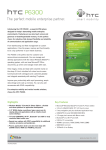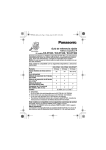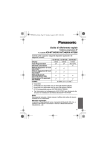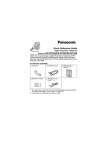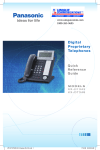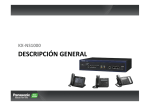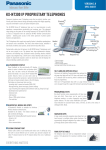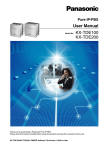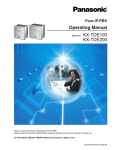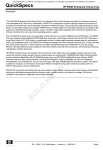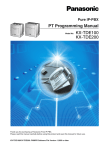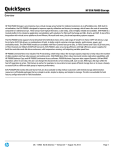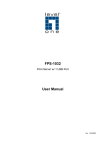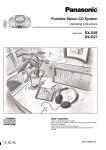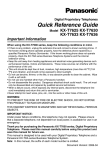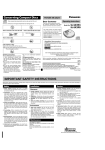Download KX-NT307
Transcript
NT307M-b5.fm Page 1 Tuesday, May 22, 2007 11:43 AM Installation Instructions Bluetooth Module Model No. KX-NT307(PSLP1528) Bluetooth Ver. 2.0 + EDR Installation Operation Installing the KX-NT307 Bluetooth Module 1) Disconnect the AC adaptor and/or Ethernet cable from the IP proprietary telephone (IP-PT) and make sure that the power is off. CAUTION: Before touching the module, discharge static electricity by touching ground. Otherwise, this module may malfunction due to the static electricity. 2) Remove the screw covers with a pointed object and the two screws from behind the IP-PT’s LCD display, as shown below. This module allows for third party Bluetooth headsets to be used with the KX-NT343, KX-NT346, and KX-NT366 IP-PTs. It is not guaranteed that all features of the Bluetooth headset can be performed when used with this module. • One Bluetooth headset may be registered to the module. • This module supports Bluetooth devices that use the headset profile (HSP) and hands-free profile (HFP). Registering the Bluetooth headset 1) Press (PAUSE) → → (ENTER). 2) From the Bluetooth headset, set it to pairing mode by following the instructions provided with the Bluetooth headset. 3) Enter the Passkey by following the instructions provided with the Bluetooth headset, or by confirming with the manufacturer of the Bluetooth headset, and press (ENTER). • When registration has been completed, a confirmation tone will be heard. • If a warning tone is heard, confirm the headset’s passkey, 3) Detach the back cover using a pointed object via the hole situated at the top of the cover (C). C D press 4) Press CANCEL (CANCEL), and perform step 3 again. (PAUSE) to exit programming mode. • After headset registration is complete, turn the headset off then on again. • When the Bluetooth headset establishes a link to the unit, the Message/Ringer Lamp flashes green for 3 seconds. Note: 4) Install the KX-NT307 Bluetooth Module to the designated slot (E), as shown below. E 5) Reattach the back cover with the screws from step 2 and reattach the screw covers. Then reconnect the AC adaptor and/or Ethernet cable to the IP-PT. • If you have already registered a Bluetooth headset that you did not wish to register, overwrite the headset by registering the correct headset. • For more information about confirmation and warning tones, refer to the User Manual of the PBX. Assigning a Headset Mode button A CO button can be assigned as a Headset Mode button. 1) Press (PAUSE) → the desired CO button → → (ENTER). • The Headset Mode button can be used to turn Headset Mode on and off. A CO button assigned as the Headset Mode button displays Headset Mode status as follows: Red: Headset Mode on Off: Headset Mode off • When Headset Mode is off, the Bluetooth headset can be used to answer calls or redial. In this case, Headset Mode will turn on automatically, and will turn off after you hang up. Confirming the ID of the Bluetooth headset and deregistering the Bluetooth headset 1) Press Trademark: The Bluetooth word mark and logos are owned by the Bluetooth SIG, Inc. and any use of such marks by Matsushita Electric Industrial Co., Ltd. is under licence. Note: In these Installation Instructions, the suffix of each model number is omitted. (PAUSE) → → (ENTER). • Confirm that the displayed ID is the ID of your Bluetooth headset. For information regarding the ID of your Bluetooth headset, refer to the operating instructions of the Bluetooth headset. • If you do not wish to perform de-registration, press (CANCEL) 3 times. CANCEL 2) Press (ENTER) to de-register the Bluetooth headset. 3) Press (PAUSE) to exit programming mode. © 2007 Panasonic Communications Co., Ltd. All Rights Reserved. Document Version 2007-06 PSQW2583ZA KK0707ME0 (M) NT307M-b5.fm Page 2 Tuesday, May 22, 2007 11:43 AM For Best Performance FCC and other information Operating Distance Please keep KX-NT300 series IP-PTs with connected Bluetooth Modules, 3 m (9 ft 10 in) or more apart from each other. Also, if a Bluetooth headset is in use near a KX-NT300 series IP-PT with a connected Bluetooth Module, other than the one it is registered to, noise may be heard. Move away from the IP-PT and closer to the one it is registered to, to improve the signal. This device complies with Part 15 of the FCC Rules. Operation is subject to the following two conditions: (1) This device may not cause harmful interference, and (2) this device must accept any interference received, including interference that may cause undesired operation. Noise Signals are transmitted between this module and the Bluetooth headset using radio waves. For maximum distance and noise free operation, it is recommended that the module is situated away from electrical appliances such as faxes, radios, personal computers, or microwaves. • Systems using the 2.4 GHz ISM (Industrial, Scientific and Medical) band may interfere with this product. Examples of such systems are cordless telephones, wireless LAN, Home RF, microwave ovens and other ISM devices. These systems may cause minor noise. Trouble shooting Problem: I cannot have a conversation using the Bluetooth headset. CAUTION: Any changes or modifications not expressly approved by the party responsible for compliance could void the user’s authority to operate this device. NOTE: This equipment has been tested and found to comply with the limits for a Class B digital device, pursuant to Part 15 of the FCC Rules. These limits are designed to provide reasonable protection against harmful interference in a residential installation. This equipment generates, uses, and can radiate radio frequency energy and, if not installed and used in accordance with the instructions, may cause harmful interference to radio communications. However, there is no guarantee that interference will not occur in a particular installation. If this equipment does cause harmful interference to radio or television reception, which can be determined by turning the equipment off and on, the user is encouraged to try to correct the interference by one or more of the following measures: – Reorient or relocate the receiving antenna. – Increase the separation between the equipment and receiver. – Connect the equipment into an outlet on a circuit different from that to which the receiver is connected. – Consult the dealer or an experienced radio/TV technician for help. Solution: • Make sure that the Bluetooth headset is properly registered to the module. • Make sure that the Bluetooth headset is properly charged according to the manual of the Bluetooth headset. • Remove the wired headset from the headset jack. Priority is given to the wired headset when both are connected. FCC RF Exposure Warning: The product complies with FCC radiation exposure limits set forth for an uncontrolled environment. The product must not be collocated or operated in conjunction with any other antenna or transmitter. Problem: I cannot register, de-register, or confirm the ID of the Bluetooth headset. Solution: • Make sure that the module is properly installed in the IP-PT. Important Information When using this module, keep the following conditions in mind. • Do not disassemble this module. Dangerous electrical shock could result. The module must only be disassembled and repaired by qualified service technicians. • This module is designed to be installed under controlled conditions of temperatures no less than 5 °C (41 °F) or greater than 40 °C (104 °F). Medical: Consult the manufacturer of any personal medical devices, such as pacemakers or hearing aids, to determine if they are adequately shielded from external RF (radio frequency) energy (the product operates in the frequency range of 2.4000 GHz to 2.4835 GHz and the power output is 2.5mW (max.)). Do not use the product in health care facilities if any regulations posted in the area instruct you not to do so. Hospitals or health care facilities may be using equipment that could be sensitive to external RF energy. WARNING: TO PREVENT POSSIBLE FIRE OR ELECTRIC SHOCK, DO NOT EXPOSE THIS UNIT TO RAIN OR MOISTURE. Panasonic Consumer Electronics Company, Division of Panasonic Corporation of North America One Panasonic Way, Secaucus, New Jersey 07094 Panasonic Puerto Rico, Inc. San Gabriel Industrial Park, Ave. 65 de Infantería, Km. 9.5, Carolina, Puerto Rico 00985 http://www.panasonic.com/csd Document Version 2007-06


